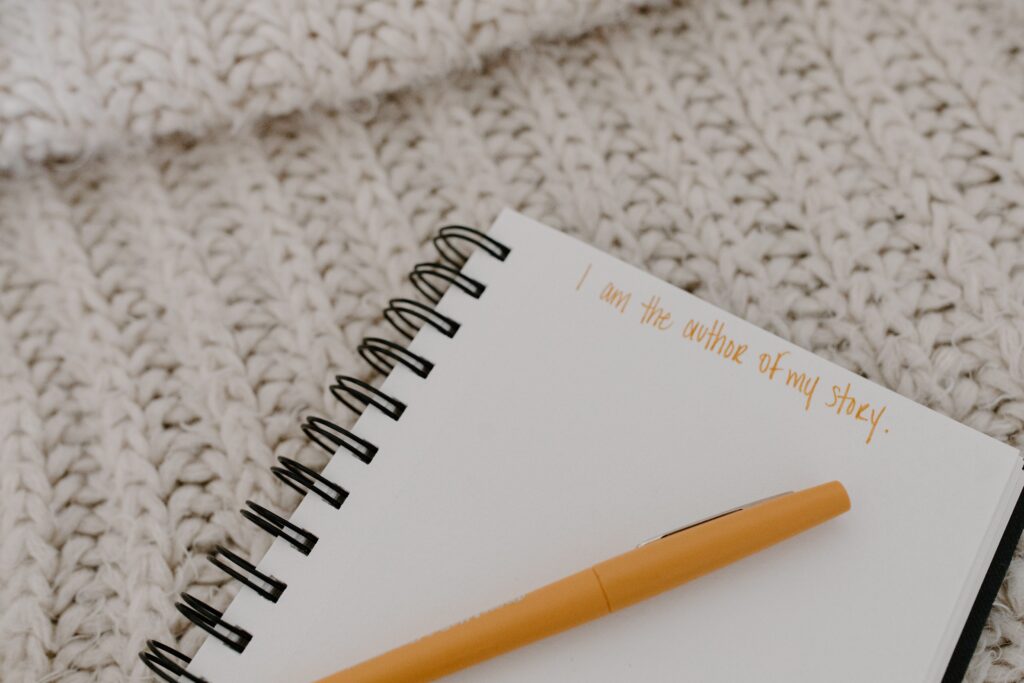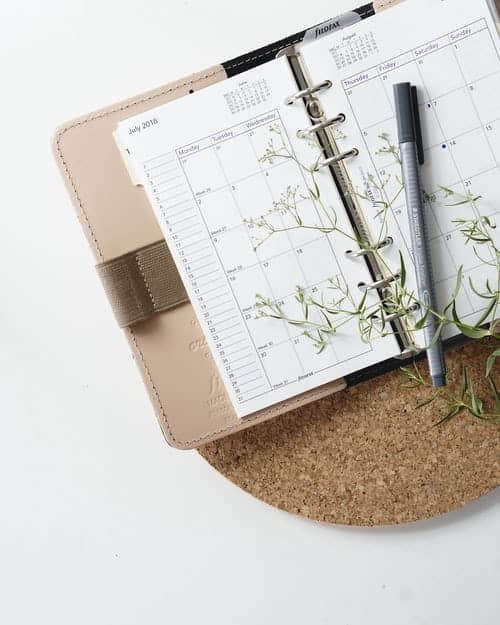40 Empty Notebook Ideas for Your Blank Journal
You’ve just found – or bought – a blank journal, but you’re struggling to know what to actually write in it.
We’ve all been there.
Instead of chucking it in a drawer or letting it collect dust and coffee stains on your desk, I’m going to give you some empty notebook ideas for you to try out.
Many of these ideas won’t just help fill in the blank pages, they’ll also help improve mindfulness, self-awareness, and your mindset overall.
I love journaling – it’s a practise that’s transformed my mindset and the way I look at life, as well as myself.
What can you do with an empty notebook or journal?
My biggest tip when starting your journaling journey is to… just start. Open the notebook, pick up your pen and get writing.
Here are some things to write in your notebook.
#1. Gratitude journaling
Practising gratitude is an amazing way to lift your mood and improve your mindset.
It encourages you to focus on what you do have, rather than dwelling on what you don’t.
Your journal is the perfect place to do this as not only does writing down what you’re grateful for make it more ‘real’ and valid in your own mind, it also gives you something to refer back to when you’re feeling low or as if nothing is going right for you.
Why not try writing a gratitude list each morning as soon as you wake up?
#2. Set goals
Writing your goals down in your journal not only helps you get clear on the outcome – which helps you get there easier – it also holds you accountable and encourages you to remember them.
What’s more, your notebook is a good place to plan out your goals.
Breaking down your big goals into smaller, short-term milestones gives you a clear roadmap and steps you need to achieve. Again, this makes smashing your goals so much simpler and more achievable, as you can literally see your plan on paper.
You can also track your goals into your journal, which is super-motivating.

#3. Journal prompts
Using journal prompts in your empty notebook is one of the most under-used tools at your disposal.
Journal prompts don’t just get your creative juices flowing, they also save you time and stress.
Have you ever sat there on your bed trying to figure out what-on-earth you need to write with one eye on the clock? Journal prompts take this uncertainty out of the equation.
They also give you a clear direction for your journal practise so that you’re journaling intentionally, with clear aims and goals, rather than randomly. This means you’re much more likely to get positive results.
Simply print or copy out a list of journal prompts that fit with your goals or needs and write about them in your journal.
If you’re looking for new journal prompts to use, I have a ton. For example:
- Journal prompts for self-care
- Shadow work journal prompts
- Journal prompts for self-love
- Journal prompts for inner child healing
If you want to gain access to 750+ journal prompts all in one place, check out my Journal Prompt Library.
#4. Affirmations
Affirmations are self-affirming statements that you repeat either out loud or in your own head to give yourself a boost of confidence or to manifest a goal.
They work by replacing negative, self-doubting thoughts with positive ones and can be really great for your self-esteem and mindset overall.
Well, guess what?
You don’t have to just repeat them out loud or in your head, you can also write them in your journal.
I often recommend only choosing 1 – 3 affirmations to work on at once so that you can give them 100% of your focus and energy.
I invite you to try writing your positive affirmations out in your journal each morning to give yourself a boost.

#5. Shadow work journal
Your journal is the perfect place to do shadow work.
Shadow work is pretty self-explanatory: it’s working on your shadow self.
Your shadow is the side of yourself that you’ve buried; it’s aspects of your true self that you often don’t even realise you’ve stuffed down into your unconscious mind because these traits are deemed undesirable or anti-social by either society, your parents, culture, or all three.
One of the best ways to start your journey into shadow work is to use journal prompts and all you need for that is an empty notebook.
#6. Plan self-care
Incorporating self-care into your everyday life is so beneficial for your mental, emotional, and physical health.
We all know this.
So, why is it so hard to do every day? Why do we tend to put it on the backburner when realistically we know it should be a priority? Why do we save it for ‘Self-Care Sunday’?
I have a theory that it’s because we simply don’t make time for it – and we should.
Your journal is a good place to literally schedule in self-care every day, as well as list down what methods of self-care work for you and what brings you joy.
#7. To-do lists
Writing out your to-do list in your empty notebook can help you not only remember what you have to do each day, but give you a feeling of satisfaction from ticking off each task as you complete it.
Doing this reduces stress, as you’re not constantly worrying about forgetting to get your tasks done, and motivates you to be more productive.
Pro tip: Make sure you write down self-care activities and fun things you plan to do on your to-do list to make sure you get them done too!
#8. Daily planner
Planning out your day and using time-management techniques like time-blocking can be done in your empty notebook.
Fail to plan and plan to fail, and all that jazz.
I personally find that planning out my weeks, months and even year in advance holds me accountable, gives me a clear roadmap that I know I need to follow to reach my goals, and keeps me on track.
#9. Mood tracker
Our moods can change dramatically from day-to-day and sometimes we don’t even realise that they’re being influenced by other people, situations, hormones, or health.
By tracking our moods every day, we can start to notice patterns, which can not only be comforting, but useful when it comes to improving our habits.
Seeing how certain variables directly affect how we feel can also encourage us to take better care of ourselves and practise self-care.
For example, if you find that you feel super-low the week before your period, you know to be extra gentle with yourself and maybe even put some time aside to take care of yourself in advance. You also may realise you want to seek professional help if your low moods are hormone-related.
Tracking your moods helps you be a little more self-aware and mindful.
#10. Habit tracker
Using your notebook as a habit tracker can help you form new positive habits and break old ones as it keeps you accountable.
By ticking each day off, you’ll get a sense of pride that you’ve stuck to your new habit another day.
In time, you’ll begin to reap the benefits of your new habit and you won’t even need to track it anymore – it’ll just be a part of your life.

#11. Reflect on your day
Reflecting on your day in your journal each evening can be therapeutic; it gives you a chance to unpack whatever’s happened that day, draw a line under it, leave it all on the page, and get a good night’s sleep ahead of the next day.
This helps relieve stress and improve self-awareness.
#12. Unpack emotions
Sometimes, when you’re feeling upset, anxious, or angry, all you need is a good vent.
Your empty journal is an awesome place to vent – it feels so cathartic to get all your worries, problems and frustrations out of your head and down on paper.
While venting to people is also great, it’s not always practical. You may not want to share certain things, even with those you trust the most, and, if the situation you’re venting about is particularly heavy, you also might not want to dump a load of trauma onto one person.
Therefore, even if you do choose to talk to someone else about how you’re feeling, your journal is the perfect place to vent.
#13. Poetry journal
Your empty notebook is a good place for you to draft and write poetry.
Writing poetry can be an effective release and feel cathartic.
It can be a way to express yourself in a manner you find difficult with ‘regular’ communication.
…Or it can simply be a bit of fun.
Writing it in your notebook means that you never lose your work; you can refer back to older poems you’ve written to either see how you’ve improved or just to reminisce.
#14. Art journal
If you’re artistically inclined, you may want to use your blank notebook as a sketchbook.
Art in any form is a beautiful way to express yourself.
Even if you don’t feel like you’re particular ‘good’ at art (‘good is subjective when it comes to art, after all), if you enjoy drawing and creating, it’s always a useful pass-time.
#15. Music journal
Whether you like writing lyrics you already know from songs you find inspiring, lyrics that you’ve come up with yourself, or musical notes, your notebook is the perfect place for this.
Music in all forms can be really therapeutic and another excellent way to express yourself and relieve stress.
#16. Free-write
Free-writing is a journaling technique that encourages you to write whatever comes to mind down onto the page. Almost like a stream-of-consciousness.
Simply pick up a pen, open your empty notebook, take a deep breathe, and let the pen do the work.
This can be an interesting exercise as, when you read back over what you’ve written, you may find that certain things are playing on your mind more than you thought.
You may also find that it feels like a massive weight has lifted off your shoulders – like you’ve vented onto the page.
Free-writing allows any repressed or censored thoughts and feelings you’ve been harbouring to come to the surface and spill out onto the page. It teaches you that your feelings are there and they’re valid.
It’s also a really easy exercise and good for those who are new to journaling as it’s less structured than other journaling techniques.

#17. Write a letter to no-one
A powerful journaling exercise that I’ve learned is to write a letter to someone that you never plan to actually send.
This is especially impactful if you’re upset or annoyed at someone, but for whatever reason, telling them everything you really feel doesn’t seem appropriate or possible.
It’s also useful when you do plan to confront someone, but want to get everything you want to say down on paper first and ‘draft’ how you want to address the situation.
Simply start the letter with “Dear…” or “To…” and let the feelings flow onto the page.
You can even write yourself a letter that you can either read to yourself at a later date or never. Perhaps try writing a letter to your future self.
#18. Manifest
Your blank journal is just begging for you to use it for manifesting.
Writing down exactly what we want to manifest can be a successful way to achieve your goals.
When you write down your manifestations, make sure to get clear on what it is you want, while also leaving some wiggle-room. Being too rigid in the exact way you want your manifestation to reach you will only slow down the process. Let the Universe (or whatever higher power you believe in) do its job; let go of what you’re asking for.
#19. Script
Scripting is a fun manifestation technique where you write down a script or a snapshot from your dream life.
For example, if you’re manifesting a certain job, write out a short scene from a day in your life at this new job.
Focus on the smells, what you can see, what you can hear, and – most importantly – how you feel when you’re there.
#20. List your favourites
Sometimes, we need a little extra help being positive and remembering what makes us happy.
Use your blank journal to write lists of what you love in life, from your favourite books and movies, to your favourite ways to unwind.
#21. List what you like about yourself
Most of us need to practise self-love more often.
A simple self-love exercise you can practise in your journal is listing what you like about yourself.
The list can be as short or long as you want.
You may find that some days it’s shorter than others, and that’s okay. Just getting into the habit of recognising what you love about yourself is positive in itself.
#22. Combat negative self-talk
We tend to be our own biggest bullies. The way we talk to ourselves inside our own head can be downright cruel.
The worst part is that once we get into the habit of negative self-talk, it spirals.
Therefore, we need to stop the cycle.
One way to do this is to write your negative thoughts down in your journal.
Choose one specific negative thought that you’re currently stewing on.
Recognise it for what it is and acknowledge it. While your feelings are valid, this particular thought isn’t helpful or true.
Write about how this thought makes you feel and then rationalise; what cold, hard evidence do you have to support this?
Usually, there is none; our negative thoughts are a result of insecurity and poor self-esteem.
Then, replace the negative thought with a positive affirmation.
#23. Deal with limiting beliefs
Limiting beliefs are certain beliefs we hold about ourselves that limit us from progressing in life.
Usually there’s no foundation for these beliefs, we’re merely falling victim to societal pressures and self-doubt.
However, that doesn’t make them feel any less real and that doesn’t prevent their impact from any less upsetting.
Try writing down your limiting beliefs and reflecting on them; try to figure out where they come from and rationalise with them.

#24. Bullet journal
A bullet journal is a blank journal, usually with with dotted pages to use as a guide for your own layouts.
This type of journal is particularly fun if you love doodling and having creative freedom over your journal.
If your blank journal doesn’t already have dotted paper, this needn’t stop you from getting creative with your pages. There are plenty of bullet journal templates and ideas on places like Pinterest.
#25. Book of Shadows
A book of shadows is a sort-of journal that Pagans, Wiccans, and witches often use to record their research, write spells, and catalogue their findings.
If you’ve been looking to start a book of shadows, why not use your empty notebook and decorate it how you see fit, rather than spending money on a completely new one.
#26. Inspirational quotes
If you see a quote that inspires or motivates you, why not write it down in your notebook so that you can remember it?
That way, you can refer back to it when you’re feeling like you need a little boost.
This is a great opportunity to practise calligraphy (if you’re interested) and decorate the page to make the quote really resonate and stand out to you.
#27. Practise your faith/Prayer journal
Your journal is a good place to practise your faith, if you have one.
Writing down verses, lessons, and prayers that are important to you can be grounding.
#28. Dream journal
Dreams don’t usually make a lot of sense, at least not first thing in the morning before you’ve had your coffee!
Writing down our dreams as soon as we wake up can help you unpack them later.
It can also help you spot patterns or reoccurring themes that pop up, which can help when analysing them.
#29. Business plans
Have you got a business or side-hustle that you want to start but don’t know how?
Why not try brain-dumping into your empty notebook and then writing up a business plan?
This will not only give you a clear purpose and roadmap to achieve your goal, it will motivate you to finally take the plunge and give you an exact place to start.
#30. Scrapbook
Scrapbooking is crafty journaling technique that usually involves sticking cut-outs, print-outs, nostalgic items, memorabilia, and stickers into an empty notebook.
You can use everything from book pages, to images from magazines, to train and concert tickets, and much more – wherever your creativity takes you.
Look at your scrapbook as a time capsule of what you love and what inspires you.
#31. Ideas
Do you find yourself getting amazing ideas, but forgetting them as quickly as they pop into your head?
Use your empty notebook to write these ideas down!
You never know when one of these ideas might become life-changing.
#32. Mood/vision board
A mood board is a collage you put together to get a feel or a theme for a project. This project might be a business idea, branding, or even room decoration.
This can help you really get clear on what you’re aiming for and make your job a lot easier down the line.
A vision board, on the other hand, is a collage you put together to help your manifestations come to reality.
You find images, quotes, and other visual representations of what you want to manifest and stick them to a board – or, in this case, a notebook – that you can look at everyday to keep you focused.

#33. Reading journal
If reading is important to you and/or you have reading goals – for example, you want to read a new book every week for a year – keeping track in a journal can be helpful.
You can also use your reading journal to document what authors, genres, and themes you do and don’t enjoy.
#34. Travel journal
Traveling can be extremely excited, but also involves a lot of planning and dedication.
Keeping a travel journal, where you write about all the places you’ve been and places you want to go, as well as checklists of things you need to bring, cost breakdowns, and the logistics of travelling, can help you keep track so that you can just enjoy the experience.
#35. Moments you want to remember
Life is full of little moments that bring us joy that, when we’re in low moments, we wish we could harness.
Writing down moments that you want to remember right after they happen can help solidify them in your mind, recognise how grateful you are for them, and give you something to look back on when you need it.
#36. Your achievements
I firmly believe that we all need to celebrate our wins a little more.
When you achieve something, no matter how small, write it down in your journal.
You got out of bed today after getting your heart broken? Good for you.
You did yoga today for the first time in months? You should be proud.
Your small business just had its best month ever? Give yourself a pat on the back!
The simple act of writing it down means you’re acknowledging your success.
You can then look back at this when experiencing self-doubt.
#37. Creative writing
Your empty notebook is a valuable place for your creative writing.
If you enjoy writing short stories or even want to draft a whole novel, putting pen to paper is a good first step.
#38. Work journal
Keeping a work journal helps you improve, stay structured, and reflect upon your job.
If you find yourself feeling overwhelmed or stagnant at work, writing about it in your journal could help.
Consider how your current work day looks, how you want it to look, how you feel, what you’re good at, and how you want to improve.
#39. Budgeting
Sticking to a budget can be seriously tricky if you don’t write it down.
You can use your blank notebook to break down your expenses, income, and budget so that you can save where possible.
#40. Exercise journal
Whether you’re just starting or you’re already deep into your exercise journey, keeping a track of your progress can be motivating.
It can also keep you mindful; while exercise is good for our body, obsession isn’t. Keeping a journal of how certain types of exercise make us feel – not just our physical progress (e.g. personal bests) – can help us remain self-aware.
This ensures that we’re moving our body for our mental health, as much as our physical health.

How to make your notebook look aesthetically pleasing
Now that you have some empty notebook ideas, what do you put on the cover to make it look aesthetically pleasing?
The beauty of a blank journal is that you can decorate it however you want!
Some ways you may want to decorate the cover of your notebook include:
- Stickers
- Collage
- Painting
- Drawing
- Quotes
- Calligraphy
Pinterest and Instagram are great places to look for templates and inspiration for decorating the cover of your blank journal.
Conclusion
Filling in your empty notebook can be daunting; when you’re staring at the blank pages, it can be tough to know what to write. Therefore, you just put the notebook back in the drawer or push it to the back of your desk where you never use it.
Hopefully, this post has given you more than a couple ideas of what to do with it.
Ultimately, it’s up to you and your intuition what you do with it and how you decorate it.
My advice is to embrace the uncertainty and let your creativity take you where it may.
If you want to get started with journal prompts, check out my Journal Prompt Library – it has over 750!

A witchy ray of sunshine who loves to help others on their journal journey. I’ve been journaling since childhood and have since gone on to earn a degree in English and a diploma in Shadow Work. I love my plant babies, yoga, and anything spooky. Find out more on my about me page.